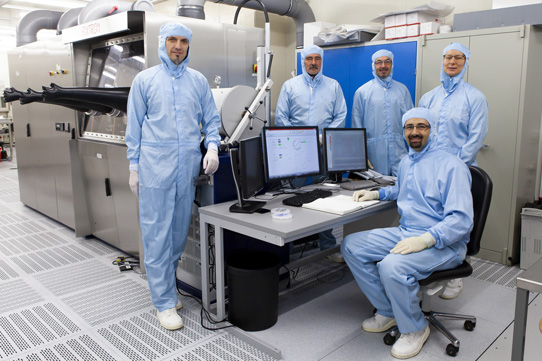- News
28 October 2019
Fraunhofer IAF claims first MOCVD production of AlScN layers for transistors
The Fraunhofer Institute for Applied Solid State Physics (IAF) in Freiburg, Germany claims to be first to manufacture aluminium scandium nitride (AlScN) by metal-organic chemical vapor deposition (MOCVD), taking a step towards its goal of developing power electronics based on AlScN transistors for industrial applications.
Transistors based on AlScN are promising for various industrial applications such as data transfer, satellite communication, radar systems and autonomous driving, especially since existing devices based on silicon are reaching their physical limit in these applications. One reason for this is the size of silicon devices, which cannot be reduced further according to existing research.
High-electron-mobility transistors (HEMTs) far surpass the possibilities of silicon devices due to the materials on which they are based. AlScN has exceptional properties, allowing higher carrier concentrations than other materials. In the future, significantly more powerful and efficient HEMTs will be realized based on AlScN, reckons Fraunhofer IAF.
Previous manufacturing processes failed due to quality and productivity
The production of AlScN involves fundamental challenges. The state-of-the-art production process grows AlScN layers via sputtering. Unfortunately, the quality of these layers is insufficient for electronic applications such as light-emitting diodes (LEDs) and high-power transistors. An alternative method is to produce AlScN via molecular beam epitaxy (MBE), with which large amounts of scandium can be incorporated in the compound. The quality is also sufficient for the production of microelectronic devices. However, the procedure is complex and the productivity too low for industrial-scale productions.
MOCVD promises industrial-grade production
The production of AlScN by MOCVD promises not only the necessary quality but also sufficient productivity for industrial applications. “We knew that previous attempts by other scientists to produce gallium scandium nitride via MOCVD had failed,” says group leader Dr Stefano Leone. “We also know that many scientists all over the world are working to develop AlScN transistors, but no one before us has succeeded in doing it by using MOCVD, even though it is a very promising approach for industry,” he adds.

Picture: The research group of Stefano Leone (bottom right) together with the MOCVD system, modified for AlScN growth.
MOCVD reactor modified for scandium precursor
The challenge for researchers at Fraunhofer IAF is that there was no gas source for scandium. The precursors for scandium are very large and difficult to bring into the gas phase. “We studied the best possible precursor for scandium and planned adjustments of our MOCVD reactor for the necessary procedure,” says Leone. “We did a lot of research and had numerous discussions until we developed a setup that we are now even patenting. We have now succeeded in growing AlScN layers via MOCVD with a very high crystal quality and the right amount of scandium in order to develop the next generation of power transistors,” he adds. The MOCVD system at Fraunhofer IAF has been modified by the research group to enable a high-quality and reproducible AlScN production process.
First MOCVD-grown AlScN layers for transistors
After successful deposition of AlScN in the MOCVD system, the first AlScN layers for transistors were produced. The layers have already yielded promising results, with sheet resistance of ~200Ω/sq., mobility of ~600cm2/Vs and charge carrier density of ~4.0x1013cm-2.
The current goal of the researchers is to reduce the sheet resistance and to further increase the mobility and material quality. This should improve the performance of future transistors, so Fraunhofer IAF aims to take a significant step towards its goal of providing AlScN HEMTs for industrial power electronic applications.
Aluminium scandium nitride exhibits ferroelectric behavior


